 |
 |
 |
 |
 |
 |
 |
 |
The fate of the Jews of Macedonia and Thrace hinged upon the relationship between Bulgaria and Germany. In WW2, Bulgaria, initially neutral, then became part ally, part satellite of Germany before making peace with the Allies and declaring war on Germany in September 1944. Always maintaining its sovereignty and forever opportunistic, Bulgaria had entered the conflict solely for reasons of territorial aggrandisement. In this it succeeded. In September 1940 part of Southern Rumania was ceded to Bulgaria, to be followed in April 1941 by the acquisition of Macedonia from Yugoslavia and Thrace from Greece. Together with these latter territories came Jewish populations of about 8,000 in Macedonia and approximately 6,000 in Thrace.
Bulgaria was prepared to introduce some anti-Jewish legislation along lines similar to that enacted in the Reich and countries occupied by Germany, i.e. definition, expropriation and concentration, although stopping short of the final step in the process, deportation. Whilst this was true for the Jews of "Old Bulgaria", it did not apply to the newly acquired Jewish populations of Macedonia and Thrace, who were denied Bulgarian citizenship and thus protection from the worst excesses.
Jews had lived in Macedonia since Roman times. The Jewish community of Thrace could trace its origins back to 1542 with the arrival of refugees from Spain. Both communities consisted in the main of Sephardi (or Spanish) Jews. They spoke a Spanish dialect, Ladino, and had little in common, other than a shared set of religious beliefs, with the Ashkenazi Jews of Central and Eastern Europe.
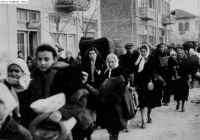 |
| Deportation * |
In January 1943, Theodor Dannecker, a representative of Adolf Eichmann’s RSHA Department IVB4 arrived in Bulgaria from France (where he headed the Jewish bureau of the Gestapo). His mission was to deport as many Jews as possible, as quickly as possible. The Bulgarian Minister of the Interior, Petur Gabrovski, now declared himself willing to deport 14,000 Jews from Macedonia and Thrace. The Bulgarian Commissar for Jewish Affairs, Aleksander Belev, proposed adding a further 6,000 Jews from "Old Bulgaria". On 22 February 1943 Dannecker and Belev concluded a written agreement providing for the deportation of a total of 20,000 Jews.
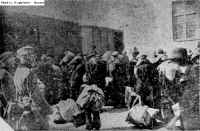 |
| Deportation by Train * |
 |
| Deportation by Ship * |
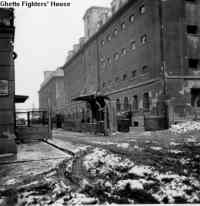 |
| "Monopoly" Warehouse * |
With the exception of twelve who died en route, all of them perished in the gas chambers, including 2,000 children below the age of sixteen. Only 200 Macedonian Jews survived the war. A similar number of Thracian Jews survived, either fighting with the partisans or hidden by their Christian neighbours. An undetermined number also escaped to the Italian zone of occupied Greece in 1941 and 1942.
Survivors of Treblinka would later comment on the appearance of these Jews from distant lands. Jacob Wiernik recalled:
"The Bulgarian Jews were tall, strong and manly... the hangmen were jealous of the victims fine appearance and maltreated them that much more."
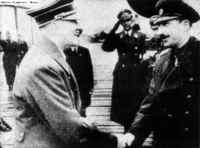 |
| King Boris and Hitler * |
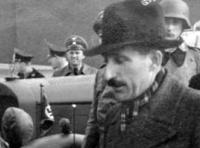 |
| King Boris * |
Jews were deported to the interior of the country, where nearly 20,000 lived in cramped quarters and many men were put into forced labor. An undetermined number of Jewish men — most likely in the tens of thousands — were forced to work at 112 labour camps around Bulgaria during the war, in conditions of malnourishment, exploitation, and brutal labor. The work consisted primarily of road and railway construction, often in difficult marshy locations, involving long work days, heavy work norms, and exposure to extreme temperatures. These prisoners faced frequent beatings by superiors, subsisted on an inadequate diet, and lacked the clothing or boots needed for working in the cold, and in the rugged terrain.
Jews continued to be subjected to discriminatory legislation until on 9 September 1944, as Soviet troops invaded the country, the government revoked all anti-Jewish laws and Jewish rights were completely restored.
Ultimately, no Bulgarian Jews were deported to the extermination sites from Bulgaria itself. In fact, Bulgaria was the only country under German influence or control whose Jewish population actually increased during the war years - from 45,565 in 1934, to 49,172 in 1945. It is a record of which Bulgarians are justifiably proud, although the abandonment and subsequent murder of the Jews of Macedonia and Thrace should not be forgotten.
In September 2005, Macedonian President Branko Crvenkovski, Prime Minister Vlado Buckovski, local public figures, representatives of the diplomatic corps to Macedonia, and Jewish communities from Israel, the United States, and Russia attended a ceremony in Skopje marking the construction of a Memorial Holocaust Centre.
"The Memorial Holocaust Centre, in a symbolic way, will bring the victims of Treblinka home to Macedonia," Buckovski said, after laying the cornerstone of the centre at the location of the former Jewish settlement in Skopje. The centre should be completed within a three-year period, financed by means provided from the denationalization of the property of deported Jews, and will include a Holocaust museum and an institute for Jewish and multi-ethnic studies.
The Central Database of Shoah Victims' Names (Yad Vashem)
Photos:
GFH *
Internet *
Sources:
1) Hilberg, Raul. The Destruction of the European Jews, Yale University Press, New Haven, 2003
2) Arad, Yitzhak. Belzec, Sobibor, Treblinka - The Operation Reinhard Death Camps, Indiana University Press, Bloomington and Indianapolis, 1987
3) Gutman, Israel ed. Encyclopedia of the Holocaust, Macmillan Publishing Company, New York, 1990
4) Gilbert, Martin. Atlas of the Holocaust, William Morrow and Company Inc, New York, 1993
5) Wiernik, Jacob. A Year in Treblinka, New York, 1944
6) Wyman, David S. ed. The World Reacts to The Holocaust, The John Hopkins University Press, Baltimore, 1996
7) Report by the Conference on Jewish Material Claims Against Germany
© ARC (http://www.deathcamps.org) 2005